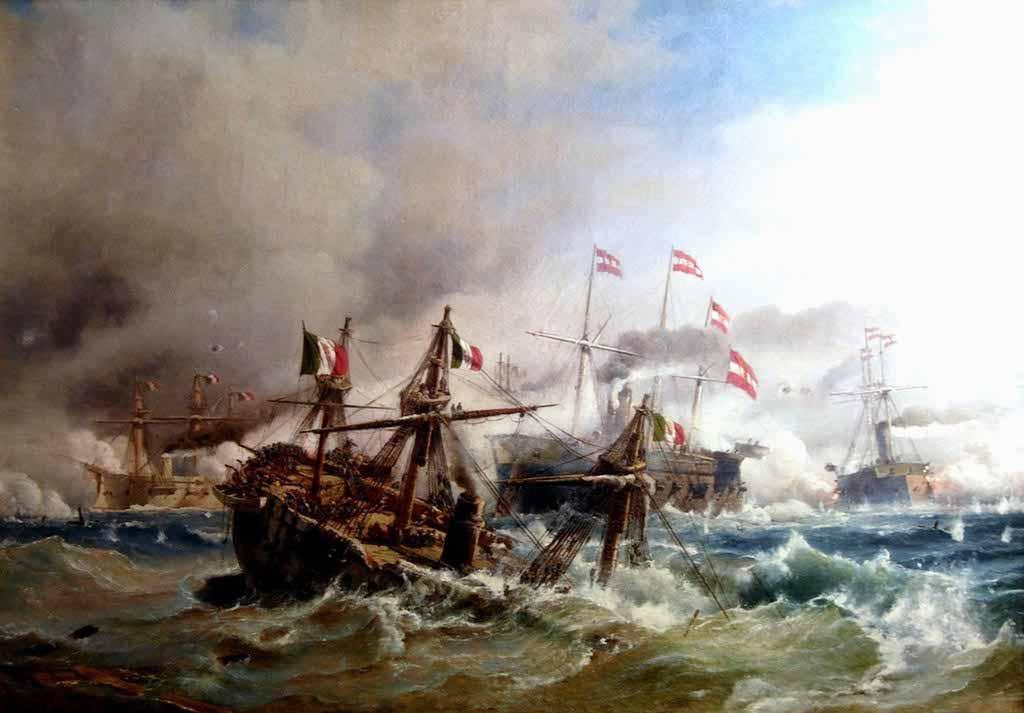
28 minute read
THE IMPERIAL (AND) ROYAL NAVY
As a land power in the fi rst place, the Habsburg Empire had no permanent navy before the end of the eighteenth century. Th e predecessor of the Navy was established in Trieste in 1786 by Emperor Joseph II. When Austria took possession of Venice, Dalmatia and Istria in 1797, on the basis of the former Venetian Navy was established the Imperial-Royal Navy (kaiserlich-königlich Kriegsmarine). Its name was changed to Imperial and Royal Navy (kaiserlich und königlich Kriegsmarine, császári és királyi haditengerészet) in 1889. Th e Habsburg rulers and the state bureaucracy traditionally had little interest in or understanding of the signifi cance of sea power for the Empire. Th is was one of the main reasons for the slow development and the underfi nanced state of the Austrian (after the Compromise between Austria and Hungary of 1867 Austro-Hungarian) Navy during the nineteenth century. In the greatest part of its history, the Navy was the “stepson” of the Habsburg armed forces, no more than a mere coastal defense force. In the history of the Austro-Hungarian Navy there were two great periods of development. Th e fi rst period began in 1850, after the shock of the Revolution of 1848. Th e tempo of the development accelerated under the command of Archduke Ferdinand Max (1854-1864), younger brother of Franz Joseph, the ill-fated later Emperor of Mexico (1864-1867). Th is period culminated in an ironclad naval arms race with the eternal rival Italy and in the victory over the Italian fl eet at Lissa in 1866. After the death of Wilhelm von Tegetthoff in 1871, the greatest Austro-Hungarian naval hero, the victor of Lissa, who was the commander of the Navy from 1868, it began a long period of stagnation and frustration again.
After more than two decades of stagnation the new period of development began in the 1890s. External and internal factors as well played significant role in the development of the Austro-Hungarian Navy in this period. In the age of navalism the sea power became more and more important and even a land power, the Austro-Hungarian Monarchy had to follow the international trend. It was an important factor too, that the formal ally of the Dual Monarchy the eternal rival Italy, after its defeat at Adua (1896) turned to the eastern Adriatic again, with the claim of unify the Italians living in the Austro-Hungarian Monarchy with the kinsman in the Kingdom of Italy. Th e Russo-Japanese war intensifi ed the Austro-Hungarian fears of an Italian assault on the Adriatic coastline. Th e domestic factors also helped the development of the Austro-Hungarian Navy. Th e emerging new political parties in Austria had a pro-navy sentiment and thanks to the growing domestic industrial orders the representatives of the heavy industry became friends of the Navy. And one of the most important things: the new heir of the throne Archduke Franz Ferdinand became the patron of the Navy. Th e intensive development began in 1904. Th e budget of the navy increased nearly by 400 percent between 1904 and 1914, while the Navy’s quota in the defense budget grew from 7 to 25 percent. Th is period culminated in a dreadnought naval arms race with Italy.
Advertisement
Austria took possession its fi rst territory on the Adriatic coast, the city of Trieste in 1382. Th e Kingdom of Hungary after seizing the Croatian throne reached the Adriatic in 1102. In 1526, after the catastrophic Hungarian defeat by the Turks at the Battle of Mohács the Austrian Habsburgs seized the Hungarian and the Croatian thrones, and the two countries became parts of the Habsburg Empire. In the period of the long wars with the Turks, who possessed the central part of Hungary, the Habsburg rulers were less interested in maritime aff airs. Th ey began to show some interest to the sea power only in the 18th century. Two short lived initiatives to establish a navy took place under Emperor Karl VI and later under Empress Maria Th eresia, but until the end of this century Venice dominated almost the entire eastern coastline of the Adriatic. Th e permanent navy, with two small ships was fi nally established in 1786 in Trieste. In 1797 Venice, the “queen of the seas” was conquered by Napoleon, who deliv-
ered the city with all its possessions to Austria in the Treaty of Campo Formio. On the basis of the former Venetian Navy was established the Imperial-Royal Navy. Until 1848 the majority of the offi cer corps was Venetian, and the service speech of the Navy was Italian.
Th e revolutions of 1848 shook the foundations of the Navy; grave problems emerged with the loyalty of the offi cer corps and also with the material state of the fl eet. Great reforms had begun in 1850 under the leased Danish Vizeadmiral Hans Birch von Dahlerup (1849-1851). Th e two main aims were to Germanize the Navy, especially the offi cer corps and to catch up in material strength the combined fl eet of the Italian states. In 1850, German had replaced Italian as the service speech, the Ma ri ne akademie was moved from Venice to Trieste and the offi cers who were not able to learn in German were expelled. Th e Flottengesetz (Navy Law) of 1850 ordered to build six sailing ships of the line along a few dozens of other smaller ships, a great step forward, because this type of ship the Navy never had had before. Despite the Flottengesetz only one ship of the line was actually built, but as a screw steamer. In 1854, the younger brother of Franz Joseph, Archduke Ferdinand Max held the post of Marinekommandant (Commander of the Navy) (1854-1864). Th e talented and energetic young archduke with his brother behind his back successfully accelerated until than slow development the Navy. His fi rst great success came in 1857 when he succeeded to create a separate budget for the Navy, which was no more part of the Army’s budget. Th is budget almost quadrupled in the next few years.
After the catastrophic war of 1859, Archduke Ferdinand Max doubled his eff orts to modernize and to strengthen the Navy. Ironically his major ally in this struggle was the threatening naval superiority of the newly created Kingdom of Italy. With the advent of the ironclads an ironclad naval arms race evolved from 1861 between Austria and Italy. Under Archduke Ferdinand Max seven Austrian ironclads were built, while the Italians built or purchased twelve. In 1862 a separate Marineministerium (Ministry of Marine) was established. Soon after the departure of the archduke for his short and ill-fated career as Emperor Maximilian of Mexico, the Marineministerium was dissolved. Th e short-lived independence of the Navy ended for all, it came under the administration of the Marinesektion of the Kriegsministerium (Ministry of War). Th e post of the Marinekommandant was vacant until 1868.
Fortunately for the Navy Archduke Ferdinand Max had a great successor, a rising star who was accepted as an unoffi cial leader of the Navy: Wilhelm von Tegetthoff . During the war with Denmark in 1864 he distinguished himself as the commander of the small Austrian squadron in the Battle of Heligoland, and was promptly promoted to Kontreadmiral by Franz Joseph. In the war with Italy in 1866 he commanded the inferior Austrian fl eet against the Italian fl eet in the Battle of Lissa and achieved the greatest victory in the history of the Austrian Navy. Franz Joseph promoted him to Vizeadmiral but contrary all expectations the post of Marinekommandant still remained vacant. Finally, a Habsburg familiar tragedy helped Tegetthoff to the post of Marinekommandant. Tegetthoff led the Austrian delegation which successfully negotiated in Mexico about bringing home the mortal remains of the executed Emperor Maximilian. Th e deeply touched Franz Joseph after this diplomatic success fi nally appointed Tegetthoff to Marinekommandant in 1868.
Between the war of 1866 and the appointment of Tegetthoff , something of immense importance happened: Th e Compromise (Ausgleich, kiegyezés) of 1867. Th e Habsburg Empire became Dual Monarchy two separate and equal states each possessing its own constitution, parliament and government. Th e two halves of the Empire, Austria and Hungary were tied together in the person of the Emperor (Emperor of Austria and Apostolic King of Hungary) and by the system of common aff airs as foreign aff airs, war and the fi nance of them. Th ree so called common ministries were established: Ministry of Foreign Aff airs, common Ministry of War and common Ministry of Finance, all in Vienna. Both states had their own separate ministries of fi nance and ministries of war, the latter with minor importance. Th e legislative power of the Austrian Reichsrat and the Hungarian Parliament (Országgyűlés) over the common ministries was exercised by the delegations (Delegation des Reichsrates in Austria, az Országgyűlés közösügyi bizottsága in Hungary), two sixty-member bodies elected by each of the parliaments. To demonstrate their absolute equality they met alternately in Vienna and
— 14 —
1 Th e Battle of Lissa 20 July 1866
Budapest. Th ey sat separately, and the budget proposals of the common ministries were laid before both at the same time by the common ministers. In fact the meetings of the delegations were the place of political show and circus rather than real decisions. Real decisions were made on the common Council of Ministers (gemeinsamer Ministerrat), the informal common government of the Empire.2 Th e question of which proportion of the common expenses each half of the Monarchy would bear, the so-called Quota had to be negotiated every ten years. Th e Hungarian contribution (Quota) was originally 30 percent, which rose gradually and in 1907 reached 36.4 percent.
Th e greatest part, more than 90 percent of the common expenses was the budget of the common Army and the Navy. Th e armed forces of the Dual Monarchy had three levels. Th e most important were the common Army and the Navy. On the second level there were the militias of both states, with their own ministries: the k. k. Landwehr in Austria and the m. kir. Honvédség in Hungary. On the third level were the Landsturm in Austria and the Népfelkelés in Hungary, which were wartime third class militias. Th e title of the common institutions before 1889 was k. k. or cs. kir. (kaiserlich-königlich, császári-királyi). Th e Hungarians were keen to be seem as absolute equals in the Dual Monarchy, so after a long struggle Prime Minister Kálmán Tisza succeeded in 1889 to change the title of common institutions to imperial and royal (k. u. k., cs. és kir., kaiserlich und königlich, császári és királyi). Th e naval ensign, however, remained the old red-white-red fl ag with the Austrian crown as remained the German service speech. In 1915, Franz Joseph authorized the new naval ensign, which was half Austrian and half red-white-green Hungarian with both crowns. Th e introduction of the new fl ag was postponed until the end of war.
Tegetthoff , as newly appointed Marine komman dant made a proposal for the administration and organization of the Navy. He knew that Franz Joseph would not agree with the idea of the independent Navy, so he proposed a subordinated but autonomous Navy for the Emperor. Franz Joseph was content with his proposal and appointed him
— 15 —
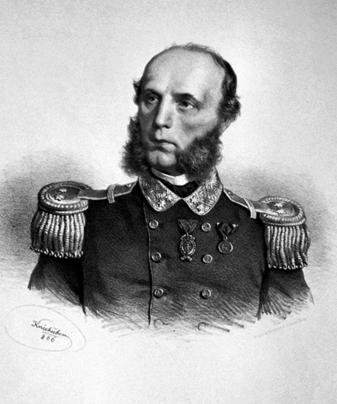
2 Vizeadmiral Wilhelm von Tegetthoff
to Chef der Marinesektion too. From Tegetthoff until 1917 all the Marinekommandants were appointed automatically as Chef der Marinesktion. In this administrative system the war minister was responsible for the navy to the delegations.3 As the budget and the importance of the Navy grew around the turn of the century, its unequal and subordinate position became more and more disadvantageous. Marinekommandant Herman von Spaun launched a plan to establish an Admiralty in 1900, but Franz Joseph rejected it. Th e Heir of the Th rone Archduke Franz Ferdinand planned to create a separate Ministry of Navy after coming to the throne, despite the fears that, with four common ministries the Hungarians might demand to transfer some of them to Budapest. Th e assassination of Franz Ferdinand hindered the establishment of the new ministry, and the system laid down by Tegetthoff remained in use until the very end of the Dual Monarchy.
As the Dual Monarchy itself, the Imperial and Royal Navy was a multiethnic and polyglot force. Naturally, especially in the fi rst decades the bulk of the crews came from areas adjacent to the Adriatic. Croatians (mostly from Dalmatia4) formed the largest national group they were followed by Italians, Germans and in minor numbers of other nationalities. In 1887 46 percent of the crews were Croatians and 33 percent were Italians.5 Afterwards, the Army Service Law of 1889 had begun to increase the number of the Hungarians among the recruits. While the number of the Italians decreased, immediately before the war Hungarians constituted the second largest group of the personnel behind the Croatians. In 1913, 31 percent of the crews were Croatians, 20 percent were Hungarians, 17 percent were Germans and 14 percent were Italians.6 Th e number of the crews on active service rose from 7,000 to 14,000 between 1887 and 1913. Among the crews was some unoffi cial specialization: Croatians and Italians mostly worked on deck, Germans and Czechs tended to the mechanical and electrical services, while Hungarians served mainly as gunners. Th e petty offi cer corps was dominated by Germans and Czechs.
Th e offi cer corps was dominated by Germans, their representation was a steady 50-55 percent throughout the decades of the Dual Monarchy. In 1910, the 897 offi cer corps constituted of 51 percent Germans, 13 percent Hungarians, 10 percent Italians, 10 percent Croatians, 9 percent Czechs and in minor numbers other nationalities.7 Th e majority of the offi cer corps were graduates of the k. u. k. Marineakademie (naval academy) at Fiume. Entry in the offi cer corps was also possible by a two-year course after graduation in a Gymnasium (grammar school). Th e Hungarian government provided easier access for Hungarian candidates to the Marineakademie, but the majority of Hungarian offi cers soon left the naval service for a better career in the Honvédség.8 Th e most famous exemption was Miklós Horthy, the only active Hungarian admiral after 1867. Th e offi cer corps of the Austro-Hungarian Navy considered itself a small but elite group. Th e Navy also seemed relatively immune from the nationalism which plagued the multinational Dual Monarchy, and it was not until the end of the World War I that serious incidents occurred.
Th e Navy until the fi rst decade of the 20th century received scant support from the court. Contrary to his late younger brother, Emperor Franz Joseph regarded the Habsburg Empire as primarily a continental power and took little interest in naval or maritime aff airs. Personally he disliked sea voyages because he gravely suff ered from nausea. He seldom inspected his Navy, the last time in 1907. Archduke Franz Ferdinand was the direct oppo-
— 16 —
site of his uncle in regard to naval aff airs. In 18921893 he had been on a world cruise on the cruiser Kaiserin Elisabeth, and the Navy deeply impressed him. In 1902 he had given the rank of Admiral. He admired the German Kaiser Wilhelm II who was a great naval enthusiast. Franz Ferdinand was probably the most infl uential and energetic patron of the Navy, although there were times when the Heir of the Th rone’s intervention into naval affairs caused headaches to the leaders of the naval administration.
After his appointment Tegetthoff made great eff orts to modernize and strengthen the fl eet. In September 1868, he presented his ten year program, which proposed a fl eet of fi fteen armored ships and thirty-four frigates and corvettes. In 1869, the delegations voted for two armored casemate ships and for rebuilding the ship of the line Kaiser into casemate ship. Th e cost of the whole program would have been 25.3 million Guldens (50.6 Kronen)9, but it was never offi cially accepted. Th e last success of Tegetthoff was securing a record high, 11 million Guldens budget for 1871. Th e seriously ill Marinekommandant died in April 1871 at age of 43. With the death of Tegetthoff the Navy lost its greatest hero and a charismatic leader.
After the death of Tegetthoff , Baron Friedrich von Pöck, protégé of Archduke Leopold and the great rival of Tegetthoff , 10 was appointed to Marinekommandant. Pöck was ill-fi tted in every sense to the post of Marinekommandant, and a long period of stagnation and frustration began for the Navy. His only success in the fi eld of armored ships was the casemate ship Tegetthoff voted in 1875. Pöck’s incompetence, bad relations with the Emperor and with politicians combined with the economic crisis of 1873 sealed the fate of Tegetthoff ’s program. In 1878, the Navy had nine armored ships in active service and one under construction instead of the proposed fi fteen. Max von Sterneck, friend of Tegetthoff , the future Marinekommandant wrote in a letter in 1878: “this is no more stagnation, this is retrogression.”11
In 1880, when the fi rst great turret ship of the Italian navy entered in service a little panic broke out in Vienna. A board, mostly constituting of army generals, headed by Archduke Albrecht was convoked to decide for the future development of the fl eet. Pöck proposed a fl eet of sixteen armored ships and ten cruisers for 1888. In Archduke Albrecht esteem, there was no need of great expenditures on armored ships, instead of them the cheap devices of a “defensive little war” (torpedoes, mines) had to be developed. Th e majority of the board members voted along with the archduke.12 In these years, the Austro-Hungarian Navy was among the leaders in the development and use of the new weapon, the torpedo. Th e automotive torpedo was also an Austrian invention, and Whitehead in Fiume was the fi rst torpedo factory of the world.
Th e Triple Alliance with Italy in 1882 was a real catastrophe for Pöck: the Austro-Hungarian Navy lost its strongest argument for developing, the Italian menace. Pöck had a nervous breakdown in 1883, and the Emperor appointed his rival, Max von Sterneck to Marinekommandant. With Sterneck, a hero of Lissa held the post of Ma ri nekommandant again; he had been the captain of Tegetthoff ’s fl agship in the battle. He made some minor changes in the administration of the Navy, the most important was the establishment of the Operationskanzlei in 1885, which worked as a naval general staff , and he established the Marinetechnische Komitee (naval technical board). In 1884, after nearly a decade long interval works be-
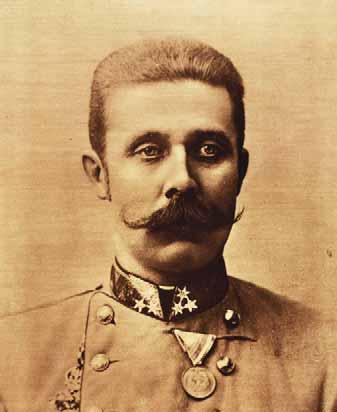
3 Archduke Franz Ferdinand, the Heir of the Th rone
— 17 —
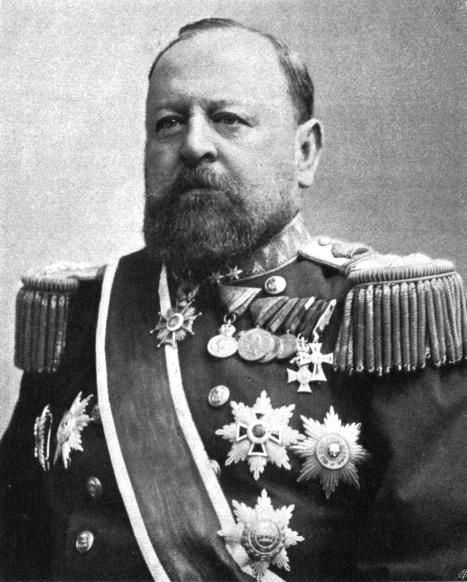
4 Admiral Hermann Freiherr von Spaun
gan on two new armored ships. Th ese were the fi rst turret ships, and the fi rst ships armed with 30.5 cm guns of the Austro-Hungarian Navy.
In his fi rst years Sterneck sympathized with the French “Jeune École” (Young School),13 so until 1892 many smaller vessels were built, along with fi ve unarmored cruisers. In the summer of 1891, Sterneck presented his fl eet program of nine battleships, six large and twelve small unarmored cruisers, twelve destroyers and seventy-two torpedo boats to the Emperor. Th is proposal was visibly inspired by the concept of “Jeune École”.14 Sterneck’s program failed, because it was not supported by the Emperor, by the Army, and even by the offi cer corps of the Navy.15
After the fi asco of his program, while on the surface he was repeating the slogans of the “Jeune École”, Sterneck was converted to the cause of armored ships. Th e 1890s brought important changes. Th e change of the naval strategy and tactics coincided with the changes in the world policy and with the transformation of the alliance system, and also with the internal political and economic changes of the Dual Monarchy. Th e emerging new parties in Austria had much more sympathy towards the Navy than the deliberately anti-navy old liberals, and the leaders of the rapidly developing Austrian heavy industry realized what lucrative possibilities inhered in the development of the fl eet. Th e fi rst sign of the changing of Sterneck’s views was the conversion of the projected third large unarmored cruiser to armored cruiser. In 1893, the delegations voted for the yearly increase of the Navy’s budget with one million Kronen. Th is rendered possible the building of the three units of the Monarch class coastal defense ships. Th ese ships were miniature versions of the standard battleships of the time, armed with 24 cm guns instead of 30.5 cm ones. With this class a new era began in the Austro-Hungarian Navy, from this date in almost every year a new armored ship was launched in the Dual Monarchy which was in marked contrast to the 1870s and 1880s.
In December 1897, Sterneck died unexpectedly. His deputy, Admiral Hermann von Spaun was appointed to Marinekommandt. Th e construction of armored ships was Spaun’s priority, and subordinated almost everything to this.16 In the spring of 1898, the new Marinekommandant presented his program of twelve battleships, twelve cruisers, twelve destroyers and seventy-two torpedo boats to the Emperor and to the politicians. A special credit of 110 million Kronen would have covered the expenses of that program.17 Unfortunately for Spaun, his program coincided with Tirpitz’s fi rst Navy Law, and with the Spanish off ering of one of their African colony (Rio Oro) to the Dual Monarchy. Th e contemporaries considered Tirpitz fi rst law as the sign of the greater German colonial activity, so the consistently anti-colonialist Hungarian government looked at Spaun’s program what served Austrian colonial aims. On the common Council of Ministers the Hungarian Prime Minister De zső Bánff y torpedoed the special credit, but the Hungarian delegation voted for the new 8200 ton battleships (Habsburg class) and for a modest yearly increase of the Navy’s budget.18 After his fi asco Spaun recognized that his long-term development projects cannot be realized without the support of the Hungarians, so he began to pursue new, pro-Hungarian politics. Th e second ship of the new battleship class was named Árpád. 19 In August 1898, Spaun made a written promise that the Hungarian industry’s share in the Navy’s orders will be in proportion to the quota in the future.20
In the summer of 1900, when his relationships with the common War Minister Edmund Krieg-
— 18 —
hammer deteriorated, Spaun tried to reorganize the Navy’s administration. Spaun planned to establish an Admiralty instead of the Marine sektion, which would have been subordinated to the common Ministry of War too, but its chef would have wider competence, and could have negotiate directly with other ministers. Th e Emperor rejected Spaun’s plan and all remained the same. After the failure of his reform initiative Spaun concentrated on armored ships. Th e delegations voted for an armored cruiser in 1900 (Sankt Georg) and for a new, 10,600 ton battleship class in 1901 (Erzherzog Karl class).
Th e year of 1904 was a landmark in the history of the Austro-Hungarian Navy. In this year the delegations voted for the fi rst extraordinary credit21 for the Navy. Th is 120 million Kronen extraordinary credit made possible the long waited and needed modernization of the torpedo-fl otilla which was neglected from 1898. Th e Austro-Hungarian fears of an Italian surprise attack on Pola, while Italy was a formal ally, similar to the Japanese attack on Port Arthur facilitated the voting of this credit. In that year was founded the Österreichisches Flottenverein (Austrian Navy League) with thirty-nine members. Ten years later the Flottenverein, which was backed by Archduke Franz Ferdinand, had 44,617 members. Th e Flottenverein’s monthly organ, Die Flagge advocated for developing both the Navy and the Austrian merchant fl eet.
Th e Austrian Finance Minister insisted that the Navy had to repay the credit from its ordinary budget. To protest against this decision, in October 1904 Spaun resigned. Fortunately for the Navy later the delegations cancelled this repayment obligation. Beside the extraordinary credit of 1904 the greatest success of Spaun was the fact, that in his years in offi ce the proportion of the Navy’s share of the armed forces’ total budget rose from 7.5 percent to 11.7 percent.
In October 1904, the Emperor appointed Admiral Rudolf von Montecuccoli to Mari ne komman dant. Montecuccoli was the last Mari ne komman dant who was a veteran of the Battle of Lissa. Mon tecuccoli inherited a more modern fl eet that Spaun seven years ago, but Italy’s superiority was still overwhelming. Th e diplomatically talented Mon tecuccoli was the man, who made the Austro-Hungarian Navy – backed by the growing support of the Heir of the Th rone, the Austrian parties and industrialists – from a coastal defense force to a Mediterranean factor. In the summer of 1905, he presented his fi rst fl eet program of thirteen battleships, twelve cruisers, eighteen destroyers, eightytwo torpedo boats and six submarines.22 In 1906, Montecuccoli prepared a memorandum on the necessity of strengthening the fl eet through accelerating the replacement of obsolete vessels. Th e main purpose of this memorandum was to pave the way for the new battleship class, the fi rst true battleships of the Austro-Hungarian Navy. At the end of 1906, the delegations fi nally voted for these 14,500 ton battleships with mixed 30.5 cm and 24 cm main battery (Radetzky class).
In July 1906, in a speech before the Austrian delegation, Montecuccoli stated that in the future the Austro-Hungarian Navy should build 20,000 ton battleships to follow the international trends.23 After the dreadnought-revolution it was a logical step to shift to the construction of true dreadnoughts. Th e most important task of Montecuccoli was in the next few years to secure the funds for the construction of the fi rst Austro-Hungarian
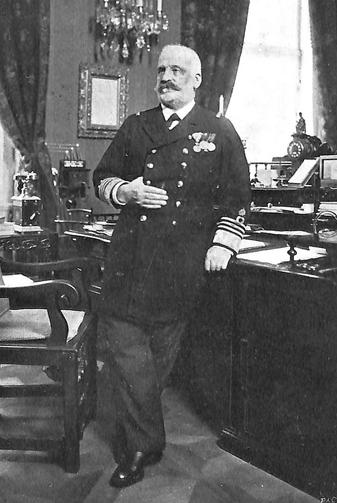
5 Admiral Rudolf Graf von Montecuccoli degli Erri
— 19 —
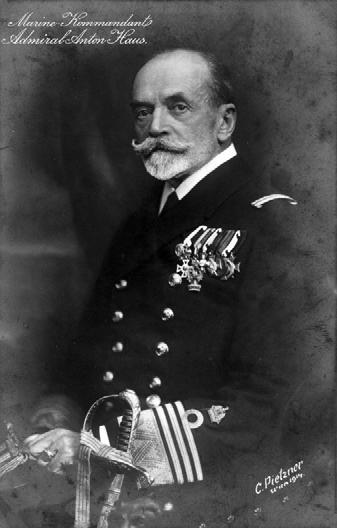
6 Admiral Anton Haus
dreadnought class. Th e Bosnian crisis of 1908 with its threat of war was favorable for additional expenditure on armaments. Referring to the Italian threat of war Montecuccoli presented in 1908 his second fl eet program of sixteen battleships, twelve cruisers, twenty-four destroyers, seventy-two torpedo boats and twelve submarines. Th is program included four 20,000 ton dreadnoughts.24 After forty years this was the fi rst fl eet program which exceeded the aims of Tegetthoff ’s program of 1868. Th e design process of the new battleships began in 1908. Italy laid down its fi rst dreadnought in 1909. As early as 1908 it was evident, that the expenses of the new construction program, consisting four dreadnoughts, three turbine powered cruisers (scouts), six modern destroyers, twelve torpedo boats and six modern submarines, could be covered only with an extraordinary credit. Th e Heir of the Th rone, Franz Ferdinand on several occasion urged the Navy in 1909 to begin the construction of the new battleships, but the 1909 political crisis in Hungary made it impossible to meet the delegations and vote for the extraordinary credit. Th us, after an agreement with the Austrian Rothschilds on fi nancial backgrounds, the Navy backed by Franz Ferdinand made an “unconstitutional” step in November 1909, before voting the expenses, ordered in a secret contract two dreadnoughts from the STT, formally “at the own risk” of the shipyard. Th e Navy promised to take over the ships when the delegations fi nally would vote the credit. Th e two dreadnoughts were laid down in 1910 in Trieste. In early 1911, the Delegations fi nally voted the extraordinary credit of 312 million Kronen. Th e Hungarian votes had their price: one third of the industrial orders went to the Hungarian industry, and one of the four dreadnoughts was ordered in the Hungarian Danubius shipyard.
Th e securing of the fi rst dreadnought class was the last success of Montecuccoli. Montecuccoli’s independent contracting of debts with the yards and banks led to a sharp disagreement between himself and the War minister in March 1912. Franz Ferdinand’s intervention prevented the scandal, but the Heir of the Th rone decided to separate the administration of the Navy and the actual commandership. In the summer of 1912, a new post was created, the Flotteninspektor (surveyor of the fl eet), which naturally weakened the position of the Marinekommandant. Th e Flotteninspektor’s task was to assume the active command of the fl eet in the case of a war. Vizeadmiral Anton Haus was appointed to Flotteninspektor. In the course of 1912 Montecuccoli on a few occasions tried to present a proposal for a second dreadnought class, but it was too early, considering the fi nancial state of the Dual Monarchy. In February 1913, Montecuccoli upon reaching the age of seventy retired and the Flotteninspektor, Anton Haus was appointed to Marinekommandant. Th e post of Flotteninspektor was cancelled.
Franz Ferdinand originally wanted to promote Haus only to Marinekommandant, while the post of Chef der Marinesektion he intended to Kontreadmiral Richard Barry. Th e Emperor balked the Heir of the Th rone’s plans and promoted Haus to Chef der Marinesektion as well. In March 1913, Franz Ferdinand tried to persuade Haus to vacate one of his offi ces, but Haus refused it. He consented only to remain in Pola. He also succeeded
— 20 —
to prevent the appointment of Franz Ferdinand’s protégé, Richard Barry to the post of Deputy Chef der Marinesektion. When Haus visited General Arthur Bolfras the Chief of the Military Chancellery of the Emperor, they opened a bottle of champagne celebrating the “multiple victories” over the Heir of the Th rone. Bolfras added that it had to take account the wish of the Emperor yet, and not the Heir of the Th rone’s.25 Nevertheless, Franz Ferdinand did not give up his plans and constantly bombarded Haus with his reform ideas. Haus despite his confl icts with the Heir of the Th rone, as Marinekommandant enjoyed a special immunity, so these confl icts did not aff ect seriously his career. Th e two most important tasks ahead of the new Marinekommandant were the negotiating and concluding of the naval convention of the Triple Alliance and the securing of the second dreadnought class. Parallel with the 1912 renewal of the Triple Alliance the Italians proposed to resurrect and renew the naval convention of 1900. In January 1913, Franz Joseph sanctioned the negotiations. Formal talks were started in May 1913 and a conference was held in Vienna in June 1913. Th e naval convention went into eff ect on 1 November 1913. Th e convention was consisted of a general agreement and of an additional agreement on the Mediterranean. Th e latter prescribed that the commander of the joint Italian-Austrian fl eet, envisioned by the convention should be alternately an Austro-Hungarian or an Italian admiral. Th e objective of the fl eet commander was the swiftest possible defeat of the French fl eet and seizing the control of the Mediterranean waters in the case of a confl ict. One year after the Austrian and the Hungarian delegations had voted the 312 million Kronen extraordinary credit Montecuccoli submitted a more ambitious plan. In March 1912 the Marinekommandant asked a 464 million Kronen credit for building a second dreadnought class along with cruisers, destroyers and submarines. Th e Emperor advised him to present his program at a more favorable time. In July he asked a modest sum for one battleship and in October 170 million Kronen for two, but in both cases his requests were rejected by the Hungarian ministers at the meetings of the common Council of Ministers. When Haus succeeded Montecuccoli, Franz Ferdinand tried to press him to pursue the construction of one battleship by the same “unconstitutional” means that the Navy had used in 1910. Despite the pressure from the Belvedere, Haus did not want to go behind the back of the politicians and in April 1913, revealed the plan of the so called “Spekulationsbau” to Hungarian Prime Minister László Lukács. Th e key fi gure was János Teleszky, Finance Minister of the Lukács and the Tisza governments. Lukács and Teleszky refused the extralegal way but Teleszky promised to bring forward the voting for the new extraordinary credit. In October 1913, at the common Council of Ministers even the Hungarian members, the new Prime Minister István Tisza and Teleszky approved the 426 million Kronen extraordinary credit for the Navy. Owing to a decision to change the Austro-Hungarian fi scal year from January-December to July-June, it was decided that the new credit would grant from 1914/1915, the fi rst full fi scal year for the Navy. In the spring of 1914 the Delegations voted for the credit. Due to the outbreak of the war none of the 24,500 ton battleships was laid down, and the program was cancelled in February 1915.
Th e First World War, or as the contemporaries called it the Great War, was the last war fought by the Austro-Hungarian Navy as the Habsburg Empire itself. Th e Navy which was developed for fi ghting a war with the Italian Navy found itself in a diffi cult situation in August 1914. Despite its limitations and the overwhelming superiority of the enemy coalition of the allied French, British and Italian naval forces on the Mediterranean and on the Adriatic the Austro-Hungarian Navy succeeded in defending the Empire’s long Adriatic coastline until the end of the war. Th e multiethnic Navy functioned clearly better during the war than many other institutions of the multiethnic Dual Monarchy. Th e Navy made the Adriatic a virtual “Austrian lake”, and tied down considerable Allied naval forces. In 1918 the internal decay and disintegration of the Monarchy had a strong impact on the Navy, but somewhat less signifi cant than on the Army. With the collapse and dissolution of the Habsburg Empire the Navy ceased to exist leaving no successors behind.









